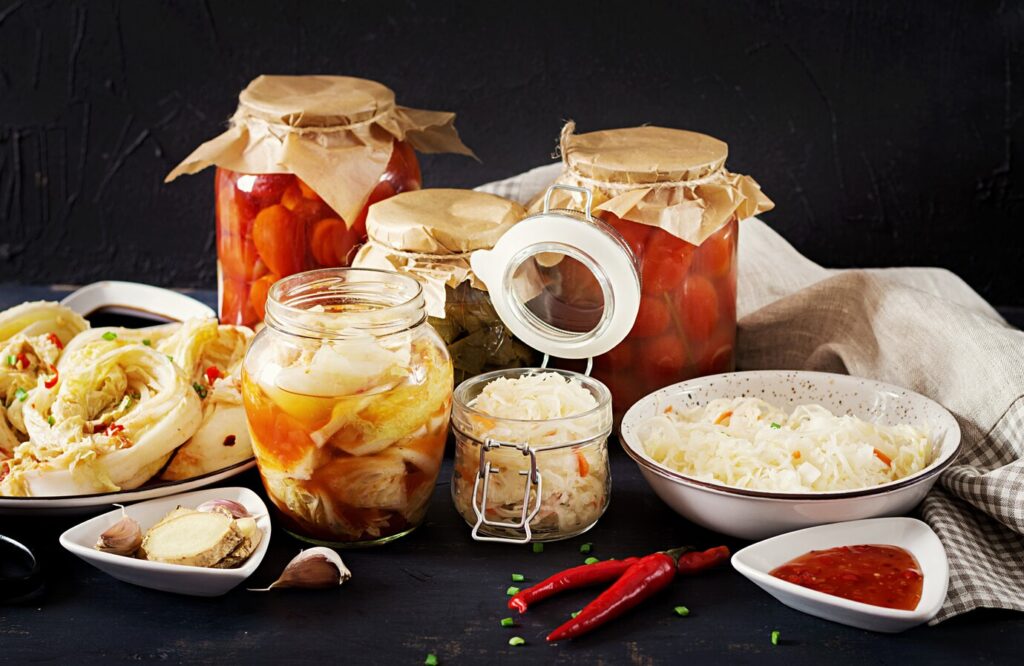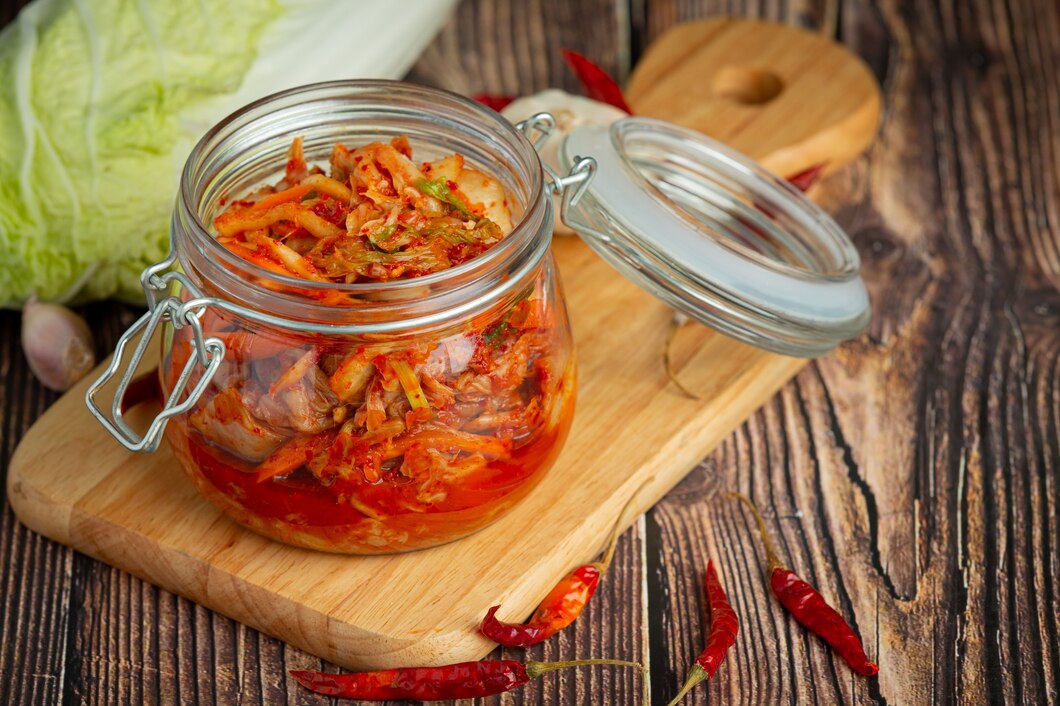The Food Blog

How Fermentation is Used in Different Cuisines
Fermentation is a time-honoured culinary art embraced by cultures worldwide. This magical transformation occurs through beneficial microorganisms—bacteria, yeast, and fungi at work. It does more than preserve; it enhances flavours and elevates nutrition. Digestion becomes a breeze, thanks to probiotics and enzymes enriching every bite.
From the tangy “sour” of sauerkraut in Germany to the “spicy” of kimchi in Korea to the rich miso in Japan, fermented foods are part of many cuisines. In this guide, we will discover fermentation across different cultures, the unique dishes they have to offer, and the health benefits of these probiotic-packed delicacies.
Asia: The Art of Fermentation in Korean, Japanese, and Chinese Cuisine

Korea: Kimchi and Fermented Soybean Paste (Doenjang)
Korean cuisine stands out for its tantalising fermented side dishes, with kimchi reigning supreme. Crafted from crunchy cabbage, peppery radish, or refreshing cucumber, kimchi boasts a symphony of flavours. Fermented with garlic, ginger, and chilli peppers, each bite packs a zesty punch. A sprinkle of salt adds to the flavour. This classic process can take days or even months. The result is a bold, tangy, spicy, and umami-rich treat.
Doenjang, a fermented soybean paste, is another Korean staple. Similar to Japanese miso, it’s made by fermenting soybeans with salt and bacteria over several months. It’s commonly used in stews, soups, and marinades.
Health Benefits:
- Kimchi is rich in probiotics that support gut health.
- Doenjang contains antioxidants and anti-inflammatory properties.
Where to Try It:
- Traditional Korean restaurants and markets serve a variety of fermented side dishes.
- Kimchi-making festivals in Korea offer hands-on experiences.
Japan: Miso, Natto, and Pickled Vegetables
Japanese cuisine heavily incorporates fermentation to create complex, savoury flavours.
- Miso is made by fermenting soybeans with koji mould and salt. It is aged for weeks to years, creating varieties with different depths of flavour. Used in soups, marinades, and glazes, miso adds a rich umami punch.
- Natto, a fermented soybean dish, is famous for its sticky texture and strong aroma. Though an acquired taste, it’s beloved in Japan for its nutritional benefits.
- Tsukemono are Japanese pickled vegetables fermented in rice bran, salt, or miso. They add a tangy, crisp element to meals.
Health Benefits:
- Miso contains beneficial enzymes and probiotics.
- Natto is rich in vitamin K2, which supports bone health.
Where to Try It:
- Local izakayas (pubs) and sushi restaurants often serve tsukemono.
- Traditional Japanese breakfasts often feature natto.
China: Fermented Tofu and Pickled Vegetables
In Chinese cuisine, fermented tofu and pickled vegetables play a significant role.
- Fermented tofu, or stinky tofu, is made by fermenting tofu in brine with herbs and spices. Its strong aroma and rich flavour make it a popular street food.
- Suan cai (fermented cabbage) and zha cai (pickled mustard tuber) are tangy veggies. They’re great in soups and stir-fries, adding rich flavour.
Health Benefits:
- Fermented tofu contains probiotics and digestive enzymes.
- Pickled vegetables are a good source of fibre and gut-friendly bacteria.
Where to Try It:
- Street food markets in Taiwan and China feature stinky tofu.
- Chinese restaurants often serve suan cai in hot pot dishes.
Europe: Fermentation in German, French, and Eastern European Cuisine
Germany: Sauerkraut and Pickled Vegetables
Fermentation is central to German cuisine, with sauerkraut being the most famous example. Sauerkraut is made from fermented cabbage. It’s a tangy, probiotic-rich side dish. People often serve it with sausages, pork, and sandwiches.
What Makes It Unique?
- Slow fermentation in brine enhances its tanginess.
- It is traditionally made in wooden barrels or ceramic crocks.
Health Benefits:
- Rich in probiotics that support gut health.
- Contains vitamin C and antioxidants.
Where to Try It:
- Authentic sauerkraut is served at German beer gardens and Oktoberfest celebrations.
- Farmers’ markets in Germany sell freshly made versions.
France: Fermented Cheese and Sourdough Bread

Fermentation is key to French culinary heritage, particularly in its cheeses and bread.
- Roquefort, Camembert, and Brie are aged with specific bacteria and moulds, giving them their distinct textures and flavours.
- Sourdough bread, or pain au levain, is made using a fermented starter culture, creating a tangy taste and airy crumb.
Health Benefits:
- Fermented cheeses contain healthy bacteria that promote gut health.
- Sourdough bread is easier to digest due to its natural fermentation process.
Where to Try It:
- French fromageries offer a wide selection of fermented cheeses.
- Artisan bakeries sell authentic sourdough bread.
Eastern Europe: Kvass and Pickled Vegetables
In Eastern Europe, fermentation is a traditional food preservation method.
- Kvass is a fermented beverage made from black or rye bread, known for its slightly tangy, fizzy taste. It is a staple in Russian and Ukrainian cuisine.
- Pickled cucumbers, beets, and cabbage are common fermented sides, offering a tangy crunch.
Health Benefits:
- Kvass contains beneficial bacteria that aid digestion.
- Fermented vegetables are rich in probiotics and fibre.
Where to Try It:
- Markets in Eastern Europe sell homemade kvass.
- Pickled vegetables are served with traditional meals in Poland, Russia, and Ukraine.
Latin America: Fermented Beverages and Pickled Foods
Mexico: Tepache and Curtido
Mexican cuisine incorporates fermented drinks and vegetables into its culinary traditions.
- Tepache is a fermented pineapple beverage with a sweet and tangy flavour, often spiced with cinnamon and cloves.
- Curtido is a fermented cabbage slaw, similar to sauerkraut, used as a topping for pupusas and tacos.
Health Benefits:
- Tepache contains beneficial probiotics.
- Curtido is rich in fibre and digestive enzymes.
Where to Try It:
- Street vendors in Mexico sell fresh tepache.
- Salvadoran restaurants serve curtido with pupusas.
Conclusion: The Global Art of Fermentation
Fermentation is a culinary symphony that dances across cultures, crafting delicious, nutrient-packed delights worldwide. From the zesty kick of Korean kimchi to the robust aroma of stinky tofu and the bubbly briskness of kvass, fermented foods promise a tantalising journey for your taste buds while boosting your well-being.
Embarking on a culinary adventure reveals a world of new flavours. These dishes not only tickle your taste buds but also offer probiotic perks and nutrient-packed goodness. So, the next time you dine out or jet-set across the globe, chase fermented specialities. Discover the enchanting power of fermentation, one bite at a time!









